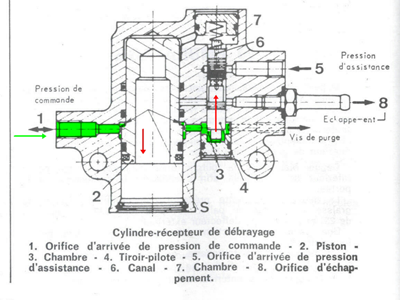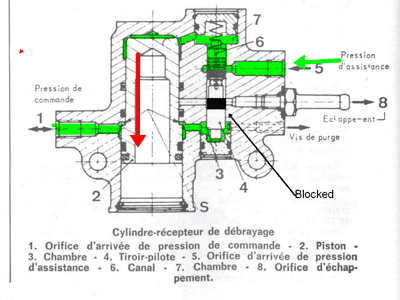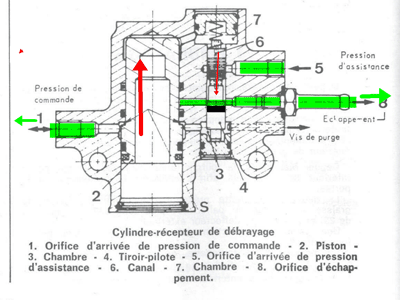| What's happening inside the slave cylinder?
My first set of drawings were from a Version Francaise book, and I
don't want to re-color the same drawings from the VE one. |
|
|
When the clutch pedal is pressed: |
 |
The driver pushes the clutch pedal which increases pressure at point
(1). This pushes the Piston (2) out and increases pressure in
chamber (3). The increased pressure in chamber (3) pushes the
slide-valve (4) in against the spring located in chamber (7). The
slide-valve (4) closes the return line to the reservoir (8) and opens the
line from the HP supply (5). |
|
(1) Connection from Master Cylinder (2)
Piston (3) Chamber (4) Slide Valve (5) Connection to HP (6) Canal
(7) Chamber (8) return to reservoir
High-Pressure actuates the clutch slave cylinder: |
 |
The slide-valve (4) has opened the HP
connection. LHM under
pressure (5) fills the chamber (7) through the canal (6). Chamber
7 is connected to the base of the piston (2) and the piston is forced
out by the HP. Declutching occurs. |
|
|
The clutch is released: |
 |
Fluid flows back to the master
cylinder(1), lowering the pressure in chamber (3). The spring in
chamber (7) presses the slide valve (4) back into chamber (3).
The slide valve closes the supply of HP(5), and opens the return connection
to the reservoir (8). The pressure of the clutch return spring
pushes piston (2) back into the slave cylinder. The LHM in the
cylinder, now displaced by the piston, returns to the reservoir via
Echappement (8). |
Remarks from the shop
manual:
- The position of slide-valve (4) is defined for each position of
the clutch pedal m and consequently, for each quantity of fluid
moved by the master-cylinder. This position depends on fluid
quantity under pressure in the control circuit of the clutch slave
cylinder.
- When the engine is stopped, or in the case of accidental drop in
the high pressure, it is possible to ensure declutching by
depressing the clutch pedal. The fluid column, moved by the
master-cylinder is enough to ensure the travel of piston (2).
Clutch pedal effort : about 30 daN (67.20 lb-ft).
|
| |
| |
| |
| |
| |
|